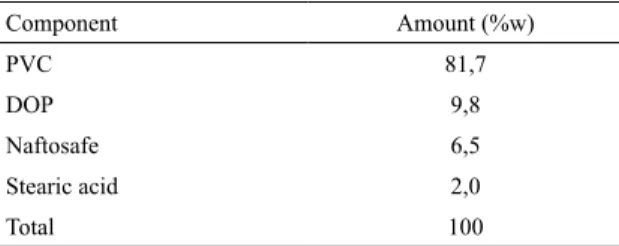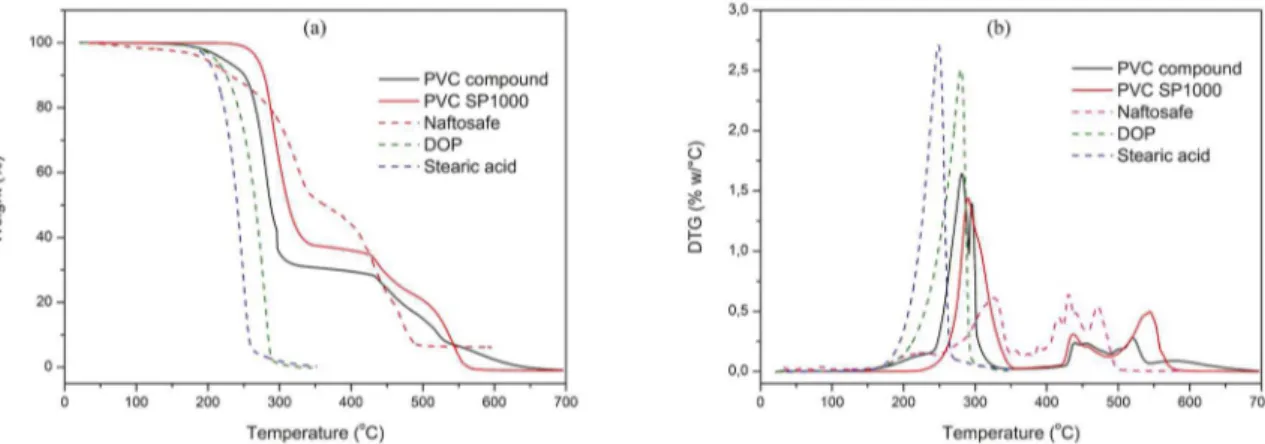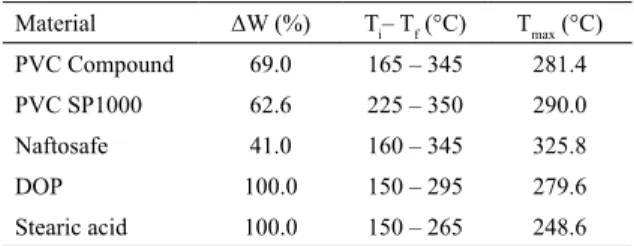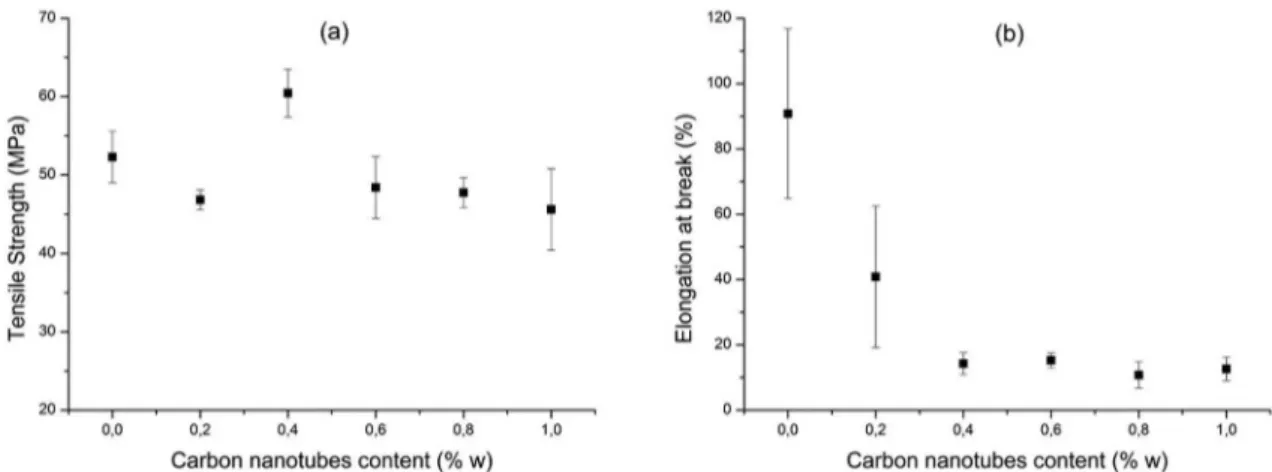Effect of Preparation Method on the Electrical and Mechanical Properties of PVC/Carbon
Nanotubes Nanocomposites
Leticia Trezecik Silvanoa , Atilio Luiz Vittorazzo Jr.b, Rogerio Gomes Araujoa,b*
Received: December 12, 2017; Revised: March 28, 2018; Accepted: June 25, 2018
The biggest challenge for the development of carbon nanotubes polymeric nanocomposites is in the suitable dispersion and distribution of the nanometric particles along the polymer matrix. Several preparation methods have been used to obtain nanocomposites, highlighting the mixture with polymer
solution followed by solvent evaporation and the hot compacting. The first one has the advantage of
allowing dispersion of the nanotubes in a low viscosity medium, while the second method is more
environmental favorable due to reduced use of solvent. The aim of this work was to evaluate the influence
of the preparation method on the electrical resistivity of PVC/carbon nanotubes nanocomposites, containing from 0.05 to 1.00%w of carbon nanotubes. The results showed a percolation threshold of 0.4%w and 0.15%w of nanotubes for the polymer solution method and hot compacting, respectively, and an electrical resistivity reduction of eight and nine orders of magnitude, respectively, compared
to pure PVC. The tensile strength of PVC/MWNT nanocomposites was not affected by the presence
or content of carbon nanotubes compared to PVC without addition of nanoparticles, regardless of the material preparation method, however the deformation at beak was largely reduced.
Keywords: Carbon nanotubes, PVC, electrical resistivity, mechanical properties.
*e-mail: araujo@sociesc.org.br
1. Introduction
Polymeric nanocomposites have attracted great interest
in scientific community since the physical properties of the matrix polymer are significantly altered by the addition of
nanoparticle amounts of less than 1% m1-7. Carbon nanotubes
are tubular carbon nanoparticles with one or more cylindrical layers of graphene, resulting in single wall (SWNT) and multiple wall (MWNT) nanotubes, respectively. The graphene structure confers remarkable properties for carbon nanotubes, such as thermal and electrical conductivity, mechanical and
chemical resistance. In addition, the low specific weigth,
the nanometric dimensions and the high aspect ratio (ratio between length and diameter) of the particles make the nanotubes advantageous for applications that require high
specific surfaces, such in the case of reinforcing agents in
materials composites.
Poly (vinyl chloride) - PVC is the third most widely used polymer in the world, below polyethylene and polypropylene, only. In 2016, over 42 million tonnes of PVC were consumed, corresponding to over 16% of total plastics demand8. The low
cost, chemical stability, mechanical and weather resistance and the ability to absorb additives, which improve their properties, are fundamental characteristics that justify such
large consumption of this polymer. The largest field of PVC
application is in civil construction, mainly in pipes, electro
ducts, window profiles, plates and electrical cable cladding9.
On the other hand, PVC has great potential for applications
in electrical and electronic devices due to its natural flame
retardancy, but for use as a barrier against electromagnetic interference (EMI shielding), the electrical conductivity of the polymer needs to be improved.
The biggest challenge for the effective use of carbon
nanotubes in polymer matrix composites lies in the homogeneous dispersion or distribution of the nanoparticles along the continuous phase. The performance of the nanocomposites depends on the degree of dispersion, the orientation of the nanotubes and the nanotube/polymer surface interaction. Therefore, the disentanglement of carbon nanotubes prior to the composites preparation process is recommended because, depending on the Van der Waals interactions between them, the carbon nanotubes intertwine forming micro or macroscopic aggregates. Therefore, the method used to prepare the nanocomposites should be able to eliminate the aggregates formed by the entanglement of the nanotubes, promoting the uniform distribution of the nanoparticles along the matrix.
Several nanocomposites preparation methods are known, with emphasis on polymer melt mixing, polymer solution mixing, in situ polymerization and mixing by hot compacting. aCentro Universitário SOCIESC - UNISOCIESC, Departamento de Engenharia Química, Campus Boa
Vista, Rua Albano Schmidt, 3333, 89206-001, Joinville, SC, Brasil
bCentro Universitário SOCIESC - UNISOCIESC, Programa de Mestrado em Engenharia Mecânica,
Polymer solution mixing method consists in promoting the dispersion of the carbon nanotubes in a solution of matrix polymer with the aid of mechanical agitation and mainly ultrasonication followed by casting and solvent evaporation10.
The great advantage of this method is the capability to nanoparticles dispersion due to the low viscosity of the solution. The use of large amounts of solvent and the need of its subsequent elimination are the major disadvantages of this method. On the other hand, by hot compacting method the nanocomposites are obtained through the dry mixing of polymer and nanoparticles powders followed by hot pressing. This method has the advantage of using a smaller amount of solvent, being suitable for industrial scale expansion.
In this work, PVC/MWNT nanocomposites with nanoparticle contents between 0.05 and 1.00%w were produced using the methods of polymer solution mixing and
hot compacting to evaluate the influence of the preparation
method on the volumetric electrical resistivity and tensile properties. Thermogravimetric analyzes were performed on the components of the PVC compound (matrix) used in the hot compacting method to characterize the behavior of each of them during the nanocomposite preparation process.
2. Experimental
2.1 Materials
For the nanocomposites preparation, multiwalled carbon nanotubes (MWNT) of NC7000 mark, supplied by Nanocyl (Sambreville, Belgium), were used. These conductive nanoparticles are produced by CVD method with an average diameter of 9.5 nm and an average length of 1.5 µm, presenting a surface area of 250 - 300 m2g-1 and
a volumetric resistivity of 10-4 Ωcm, according to supplier.
As the polymer matrix of composites, the polyvinyl chloride (PVC) NORVIC SP1000 produced by Braskem S.A. was utilized. The PVC, synthesized by suspension polymerization, was used in the powder form with particles size between 63 and 250 µm and K-factor of 65. For the hot compacting method, a PVC compound was previously prepared using the following additives: Dioctyl phthalate - DOP (INBRACIZER-10 supplied by Inbra) as a plasticizer, calcium and zinc based thermal stabilizer (Naftosafe supplied by Chemson) and stearic acid (supplied by Chemson) as a lubricant.
2.2 Preparation of composites
The PVC/MWNT nanocomposites with carbon nanotubes content of 0,05 , 0,10 , 0,15 , 0,20 , 0,30 , 0,50 , 0,70 and 1,00 %w were obtained using the hot compacting method. A rigid PVC compound, which formulation is presented in Table 1, was prepared by intensive mixing (dry blend). The MWNT was previously suspended in ethanol and ultrasonicated during 15 min to pre-dispersion of nanoparticles. The sonicated MWNT and PVC compound were mixed in a porcelain
mortar to the visually homogeneous state. After ethanol evaporation, the homogenized mixture was transferred to a hydraulic press and compacted between two steel plates heated at 170 °C and then pressed during 15 min at 19 MPa. The specimens, in a plate shape of 1,0 mm thickness, were demolded after cooling up to room temperature.
Table 1. The PVC compound formulation.
Component Amount (%w)
PVC 81,7
DOP 9,8
Naftosafe 6,5
Stearic acid 2,0
Total 100
The process parameters of the hot compaction method
were defined after several tests using PVC without addition
of carbon nanotubes, varying time, temperature and pressure. Although the PVC compound contains a large amount of thermal stabilizer (well above the percentage used in extrusion, for example), the samples obtained by compaction at temperatures above 170 ° C and/or times above 15 min showed yellowing, indicating the degradation of the polymer.
On the other hand, PVC/MWNT nanocomposites with carbon nanotubes content of 0,20, 0,30, 0,40, 0,60, 0,80 and 1,00 %w were obtained using the polymer solution mixing method. The MWNTs were suspended in 5 ml of tetrahydrofuran (THF) and homogenized in an ultrasound bath for 15 min to break up the bundles. Then, the suspension was mixed with 25 ml of PVC/THF solution (6% w/v).
The final mixture was then homogenized by mechanical
stirring for 15 min and bath ultrasonication for another 15 min, alternately, completing three cycles. At the end of the nanotubes dispersion process, the mixture was transferred to
a flat glass mold for solvent evaporation at room temperature for 24 h. The thin film with thickness of about 100 µm was
then demolded and placed into vacuum oven at 90°C for 48 h for additional solvent removal.
2.3 Raw Materials and Nanocomposites
Characterization
Thermogravimetric analysis (TG) was performed to evaluate the loss of mass resulting from the heating of PVC compound components samples (polymer and additives), used in the hot compacting method. The objective of this analysis was to characterize the thermal decomposition or
volatilization profile of the each component to predict the
PVC compound behavior, during the hot compacting process. The measurements were performed using a TA Instruments TGA-Q50. The samples of about 10mg were heated at 10 °C min-1 from room temperature to 700°C, under a synthetic
The volume resistivity was measured directly on the composites samples obtained by the both preparation processes, following the 2-point method. A Keithley electrometer Model 6517A equipped with 8009 High Resistance Test Fixture was used, applying a voltage of 10Volt and measuring the electric current11.
Tensile properties of PVC and PVC/MWNT composites were obtained based on ASTM D882-12 method. Test specimens in the shape of rectangular strips of 100 mm length (gauge length of 50 mm) and 11 mm of width were submitted to the test. The tensile tests were performed using an EMIC DL-30000 test machine, equipped with 500kgf load cell, at a crosshead speed of 5.0 mm min-1. Tensile strength,
and elongation at break of each sample were obtained based
on at least five specimens per sample.
3. Results and Discussion
Figure 1 presents the results of the thermogravimetric analysis of the PVC compound, used as the matrix of the PVC/MWNT nanocomposites obtained by the hot compacting method, in comparison with its components. The weight loss behavior of PVC (SP-1000) occurred in two distinct stages, according to Yu and collaborators12.
The first stage started at about 250 °C and is attributed to
the polymer dehydrochlorination and formation of a linear polyene structure, while the second stage occurred from 450 °C and refers to the rupture of the double bonds of the polyene structure forming volatile hydrocarbons. A similar weight loss behavior is observed in the analysis of the PVC compound, although the overlap of the weight loss of the other additives is clear.
Table 2 summarizes the results corresponding to the
first step of weight loss for the PVC compounds and its components: the weight loss percentage (ΔW), the initial and final temperature (Ti - Tf) and the temperatures of
maximum weight loss rate (Tmax). The stearic acid presented thermal decomposition between 150 and 265°C, while the DOP decomposed between 170 and 293°C. It is assumed
that the mass loss of stearic acid and DOP is attributed to thermal decomposition, since the boiling temperatures of these compounds are 383 and 370 °C, respectively. The thermogravimetric analysis made under synthetic air atmosphere led the compounds to thermal decomposition due to the presence of oxygen.
The Naftosafe thermal stabilizer, composed by calcium and zinc stearates, presented mass loss in two stages: the
first stage between 170 and 345 °C and the second stage
between 400 and 490ºC. This result agrees with Xu et al.13,
confirming the composition of the stabilizer.
It could be observed that the Tmax of PVC compound occurred at lower values of temperature than pure PVC. This behavior was also observed by Xu et al.11 for PVC
stabilized with stabilizers containing zinc ions. The relative lower decomposition temperature of this kind of PVC compound could be attributed to the generation of ZnCl2 which can catalyze the decomposition of PVC due to its strong Lewis acidity. The mass loss initial temperature of the PVC compound is 165°C, but this mass loss is relative to the thermal decomposition of DOP and stearic acid. The PVC degradation occurs above 230°C indicating that the temperature of 170°C, employed in the hot compacting method, is suitable to keep the integrity of the polymer.
The volumetric electrical resistivity behavior of the PVC/MWNT nanocomposites, obtained by the two preparation methods, as a function of the carbon nanotube content is presented in Figure 2. An eight and nine orders of magnitude reduction in electrical resistivity were observed in the nanocomposites obtained by polymer solution mixing and hot compacting methods, respectively. However, the percolation threshold found in the hot compacting method
was 0.15%w, significantly lower than that found in the
solution mixing method, which was 0.40%w. Such behavior agrees with the results of Mamunya et al.1 and Araújo10 and
is due to the establishment of a three-dimensional conductive network of nanotubes in the nanocomposites obtained by the hot compacting method. In the polymer solution mixing method, despite better dispersion conditions of the carbon
reduced in all nanocomposites formulations. This behavior suggests that the dispersion of the nanoparticles was not adequate, resulting in the formation of carbon nanotube aggregates that induce the formation of cracks in the material and premature rupture during the tensile test. The presence of the nanotube aggregates does not interfere in the tensile strength of the material, since the maximum stress of both the PVC and the nanocomposites occurs at the yield limit and is associated with the elastic deformation, in which the
deformation values are low. The effect of crack induction by
the presence of carbon nanotubes aggregates occurs after the yield limit, associated to plastic deformation, in which the test specimens are subjected to greater deformations with consequent interference of the aggregates in the viscous
flow of the polymer chains. Similar results were found
by Yazdani H et al.14 who studied composites of MWNT
dispersed in plasticized PVC matrix. These authors concluded
that a thoroughly well-dispersed filler in a polymer matrix
slightly improves its tensile strength. On the other hand,
the presence of the nanotubes significantly reduces the
deformation at break of the nanocomposites in comparison to
the unmodified polymer. They found a reduction of 3 times in deformation at break, from 450% for unmodified PVC to
150% for composite with 0,5% MWNT, while in this work a larger reduction of 4 times was observed. However, this larger reduction can be attributed to the brittleness of rigid PVC matrix of this work in comparison with plasticized PVC matrix of Yazdani composites.
On the other hand, Zanjanijam et al.16 observed a
progressive increase in the tensile strength of SWNT/PVC composites as the nanotube content was increased from 0,25 to 0.75%, however in composites with higher nanotube contents the tensile strength was practically the same as PVC
unmodified. The authors attributed this increase in tensile
strength to the adequate dispersion of the nanotubes in the polymer matrix in composites containing up to 0.75% of nanoparticles, however the poor dispersion of higher nanotube contents maintains the tensile strength unchanged in relation to the isolated polymer. Mkhabela et al.17 studied MWNT/
PVC composites obtained by melt mixing and concluded
that as the composites became stiffer because the addition
of carbon nanotubes, they turned more brittle, therefore getting easily fractured.
PVC/MWNT nanocomposites obtained by hot compacting method showed similar behavior in relation to the tensile strength, as shown in Figure 4. The tensile strength of the nanocomposites remained practically unchanged compared to PVC without addition of carbon nanotubes. However, extremely low values of deformation at break were observed in all nanocomposites and PVC without addition of nanotubes. This result indicates that the process conditions employed
in the hot compacting method were insufficient for the
total melting of the PVC particles, preventing the polymer
molecular diffusion between them. The reduction of the
Table 2. TG results of the PVC compound and its components
corresponding to the first stage of mass loss
Material ΔW (%) Ti– Tf (°C) Tmax (°C)
PVC Compound 69.0 165 – 345 281.4
PVC SP1000 62.6 225 – 350 290.0
Naftosafe 41.0 160 – 345 325.8
DOP 100.0 150 – 295 279.6
Stearic acid 100.0 150 – 265 248.6
Figure 2. Volumetric electrical resistivity behavior of PVC/MWNT nanocomposites related to carbon nanotubes content
nanotubes, a greater amount of nanoparticles is necessary for percolation, since nanotubes tend to agglomerate during the solvent evaporation step. Yazdani H et al.14
also determined a percolation threshold between 0,2 and 0,4%w for composites MWNT/plasticized PVC obtained by nanoparticles dispersion with sonication probe. The authors
affirmed that as the carbon nanotubes content exceeds the
percolation threshold, the composite enters the percolation region across which a transition takes place in the nature of
charge transport from tunneling to partial metallic diffusive
transport. They determined the volumetric electrical resistivity of 107 Ωcm (electrical conductive = 10-5 S/m) for composites
with 1,0%w MWNT, the same value determined in this work for composite prepared by polymer solution mixing. On the other hand, Wang et al.15 reported lower values of electrical
resistivity of MWNT/PVC composites obtained by mixing in solution: 105 and 104 Ωcm for composites containing,
respectively, 0.7 and 1.0%w of nanotubes. This difference
in resistivity of the materials compared to that achieved in
this work may be a consequence of the different nanotubes
dispersion conditions by the authors.
Figure 3. Tensile strength (a) and deformation at break (b) behavior of PVC/MWNT nanocomposites obtained by solution mixing method related to carbon nanotubes content
Figure 4. Tensile strength (a) and deformation at break (b) behavior of PVC/MWNT nanocomposites obtained by hot compacting method related to carbon nanotubes content
tensile strength of the PVC without addition of nanotubes, in relation to PVC obtained in the solution mixing method, was expected and is due to the presence of the DOP as a plasticizer in the PVC compound used in this method.
4. Conclusions
The preparation method influenced the behavior of the
electrical resistivity of the PVC/MWNT nanocomposites, since the percolation threshold observed in the hot compacting
method was 0.15%w, significantly lower than that found in the
solution mixing method, which was 0.40%w. In addition, the electrical resistivity reduction was nine orders of magnitude for the nnaoocomposites obtained by hot compacting and eight orders of magnitude for the solution mixing method, in the studied carbon nanotubes contents.
The tensile strength of PVC/MWNT nanocomposites was
not affected by the presence or content of carbon nanotubes
compared to PVC without addition of nanoparticles, regardless of the material preparation method. On the other
hand, the deformation at beak was largely reduced in the nanocomposites obtained by the solution mixing method, indicating the presence of carbon nanotube aggregates. The hot compacting method requires adjustments in the process conditions for a better mechanical performance of the obtained materials, although in relation to the electrical properties it has been shown more suitable.
5. References
1. Mamunya YP, Levchenko VV, Rybak A, Boiteux G, Lebedev EV, Ulanski J, et al.Electrical and thermomechanical properties of segregated nanocomposites based on PVC and multiwalled carbon nanotubes. Journal of Non-Crystalline Solids. 2010;356(11-17):635-641. DOI: http://dx.doi.org/10.1016/j. jnoncrysol.2009.09.038
2. Loos MR, Coelho LAF, Pezzin SH, Amico SC. Effect of carbon
3. Patti A, Barretta R, de Sciarra FM, Mensitieri G, Menna C, Russo P. Flexural properties of multi-wall carbon nanotube/ polypropylene composites: Experimental investigation and nonlocal modeling. Composite Structures. 2015;131:282-289. DOI: http://dx.doi.org/10.1016/j.compstruct.2015.05.002
4. Granados-Martínez FG, Domratcheva-Lvova L, Flores-Ramírez N, García-González L, Zamora-Peredo L, Mondragón-Sánchez ML. Composite Films from Polystyrene with Hydroxyl end Groups and Carbon Nanotubes. Materials Research. 2016;19(Supp 1):133-138. DOI: http://dx.doi.org/10.1590/1980-5373-mr-2016-0783
5. Coelho PHSL, Marchesin MS, Morales AR, Bartoli JR. Electrical percolation, morphological and dispersion properties of MWCNT/PMMA nanocomposites. Materials Research. 2014;17(Suppl 1):127-132. DOI: http://dx.doi.org/10.1590/ S1516-14392014005000059
6. Shieh YT, Hsieh KC, Cheng CC. Carbon nanotubes stabilize poly(vinyl chloride) against thermal degradation. Polymer Degradation and Stability. 2017;144:221-230. DOI: http:// dx.doi.org/10.1016/j.polymdegradstab.2017.08.017
7. Broza G, Piszczek K, Schulte K, Sterzynski T. Nanocomposites of poly(vinyl chloride) with carbon nanotubes (CNT). Composites Science and Technology. 2007;67(5):890-894. DOI: http:// dx.doi.org/10.1016/j.compscitech.2006.01.033
8. Ceresana Market Intelligence. Market Study: Polyvinyl Chloride - PVC. 4(th) ed. Constance: Ceresana; 2017. p. 40-80.
9. Ceresana Market Intelligence. Global demand for PVC to rise by about 3.2%/year to 2021. Additives for Polymers. 2014;11:10-11. DOI: https://doi.org/10.1016/S0306-3747(14)70175-7
10. Araujo RG, Pires ATN. Nanocompósitos PVC/nanotubos de carbono: avaliação da resistividade elétrica e efeito do solvente utilizado na obtenção dos nanocompósitos nas propriedades térmicas. Polímeros. 2013;23:839-843. DOI: http://dx.doi. org/10.4322/polimeros.2013.072
11. Girotto EM, Santos IA. Medidas de resistividade elétrica DC em sólidos: como efetuá-las corretamente. Química Nova. 2002;25(4):639-647. DOI: http://dx.doi.org/10.1590/S0100-40422002000400019
12. Yu J, Sun L, Ma C, Qiao C, Yao H. Thermal degradation of PVC: A review. Waste Management. 2016;48:300-314. DOI: http://dx.doi.org/10.1016/j.wasman.2015.11.041
13. Xu X, Chen S, Tang W, Qu Y, Wang X. Investigation of basic zinc cyanurate as a novel thermal stabilizer for poly(vinyl
chloride) and its synergistic effect with calcium stearate. Polymer Degradation and Stability. 2014;99:211-218. DOI: http://dx.doi.org/10.1016/j.polymdegradstab.2013.11.003
14. Yazdani H, Smith BE, Hatami K. Multi-walled carbon
nanotube-filled polyvinyl chloride composites: Influence of processing
method on dispersion quality, electrical conductivity and mechanical properties. Composites Part A: Applied Science and Technology. 2016;82:65-67. DOI: http://dx.doi.org/10.1016/j. compositesa.2015.12.005
15. Wang XH, Mu YH, Tang Q, Li CQ. Preparation and Performance of PVC/CNT Nanocomposite. Advances in Polymer Technology. 2018;37(2):358-364. DOI: https://doi.org/10.1002/adv.21674
16. Zanjanijam AR, Bahrami M, Hajian M. Poly(vinyl chloride)/ single wall carbon nanotubes composites: investigation of mechanical and thermal characteristics. Journal of Vinyl & Additive Technology. 2016;22(2):128-133. DOI: http://dx.doi. org/10.1002/vnl.21413



